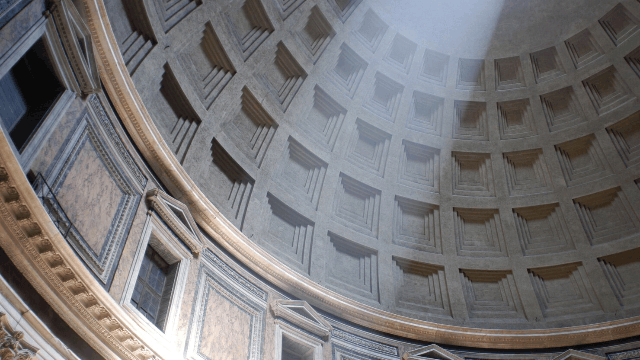Roman Pantheon - the pinnacle of dome architecture

The Pantheon is the only fully preserved ancient building in the Roman Empire. It has been intact for 18 centuries and is called "the design of angels" by Michelangelo. As early as in ancient times, the Pantheon was known as the "Roman Wonder" because of its perfect proportion.

The Pantheon is located in the center of Rome. Its name is derived from the Greek Pantheon, which means all the gods. It is a temple dedicated to the main gods of the universe. It was originally built according to Agrippa's wishes from 27 to 25 BC. The Pantheon is the only building in the Roman Empire that has been completely preserved until now. It was built in 27-25 B.C. by Agoliba, the son-in-law of Octavian, the first emperor of the Roman Empire, to worship the gods on Mount Olympia. It is a classic building in the Augustus period. The fire in AD 80 destroyed most of the Pantheon, leaving only a rectangular colonnade with 16 12.5-meter-high granite pillars. This part was used as the porch of the later reconstructed Pantheon. The top of the porch was engraved with commemorative words from the initial construction period. The original building scale of the Pantheon can still be seen from the eight huge columns on the front of the porch.
The main building of the Roman Pantheon seen today was built by Adriano the Great in 120-124 AD, a 43.4-meter-high circular hall, which still worships all the gods of Rome. In 609 AD, the Pantheon was given to the Pope, and then it was converted to a Catholic church, where many sacred remains were preserved, and renamed as the Church of Santa Maria. Later, the Lateran Pact positioned it as the Italian National Church. It was for this reason that the Pantheon survived later and was not destroyed as a pagan building.

Pantheon is the only fully preserved building in the Roman Empire. After 18 centuries of vicissitudes, the copper gate and arch roof are intact. This strong and harmonious building stands tall and upright. The colonnade outside the hall reminds people of the Greek temple and the Roman classical rotunda. The internal proportion of the hall is harmonious and very appropriate: the diameter is equal to the height, about 43 meters. The base of the great dome is built from half the total height. The circular curve on the top of the hall continues to extend downward, forming a complete sphere connected with the ground. This is a miracle in the history of architecture, which shows the profound architectural knowledge and profound calculation methods of ancient Roman architects.
There are some great Italian artists buried in the Pantheon, the most important of which is Raphael. On Raphael's tomb is a statue made by his disciple Lorenzeto: the Virgin of Stonehenge. After the unification of Italy, the Pantheon became the tomb of the king. Vittorio, Emmanuel II, Umberto I and his wife, Queen Margarita, were buried in the apses on the left and right sides of the Pantheon.

As early as in ancient times, the Pantheon was known as the "Roman Wonder" because of its perfect proportion. To this day, it is still a wonder: it stands still, just like when Emperor Hadrian ordered to build it 1900 years ago. This temple is the culmination of the dome, which is one of the greatest inventions of the Romans. The dome of the Pantheon is 143 feet in diameter, which is the distance from the shoe to the torch of the Statue of Liberty. Before the 15th century, it was the largest dome in the world, with the same height and diameter, forming a perfect hemisphere. This kind of building can only be built with concrete invented by the Romans, but they have no steel bars to strengthen concrete. How did the Romans build this dome? They mixed pumice with concrete to make a very light and durable building material. This special concrete is poured into the shell and gradually thins from bottom to top. The bottom of the dome is 22 feet thick, while the top is only 2 feet thick.
The Pantheon is not only a temple, but also a royal memorial. It was built in 118 A.D., and together with the Big Horn Douchang and Karakala Bathing Beach, it represents the splendid Roman architecture. Its main body is circular and covered with a huge dome with a diameter of 43.3 meters. This span was unmatched until the 19th century. The height of the wall supporting the dome is roughly the same as the radius of the dome. This simple and clear geometric relationship makes the single space of the Pantheon appear particularly complete, implying the meaning of the universe. There is a large round hole in the center of the dome, 8.9 meters in diameter, which is the only source of light in the temple. It is like the holy light from the eyes of heaven, creating a charm of the temple and the gods. The dome and concrete shell structure of the temple were still used continuously in the later Christian era. This kind of dome became the basic form of urban architectural art in Europe and the United States, and even changed the contour of the city, with a far-reaching impact.

